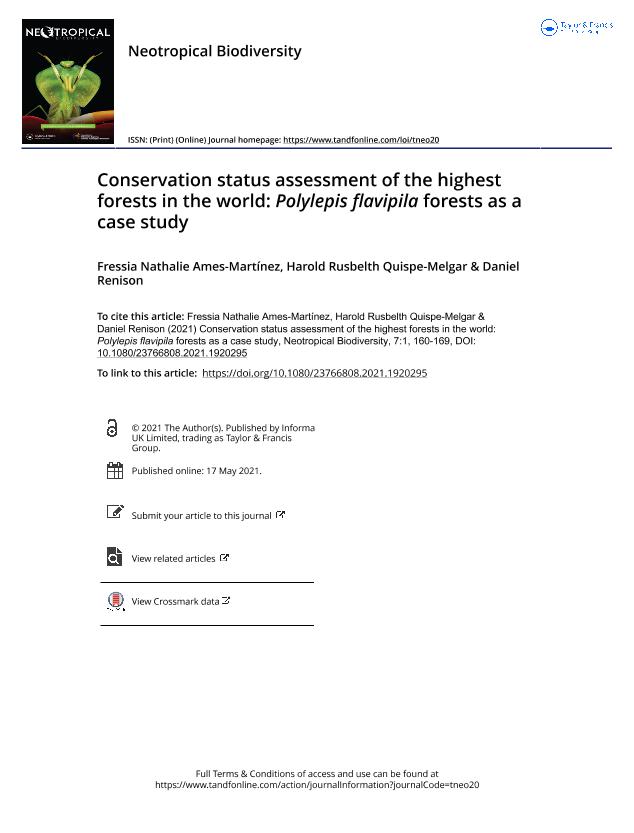Mostrar el registro sencillo del ítem
dc.contributor.author
Ames Martínez, Fressia Nathalie
dc.contributor.author
Quispe Melgar, Harold Rusbelth
dc.contributor.author
Renison, Daniel

dc.date.available
2022-04-05T23:04:46Z
dc.date.issued
2021-05-17
dc.identifier.citation
Ames Martínez, Fressia Nathalie ; Quispe Melgar, Harold Rusbelth ; Renison, Daniel; Conservation status assessment of the highest forests in the world: Polylepis flavipila forests as a case study; Taylor & Francis; Neotropical Biodiversity; 7; 1; 17-5-2021; 160-169
dc.identifier.issn
2376-6808
dc.identifier.uri
http://hdl.handle.net/11336/154464
dc.description.abstract
Polylepis forests are one of the most threatened high Andean ecosystems, with 15 species and eight subspecies being categorized as critically endangered, vulnerable or near threatened by IUCN. However, their conservation status is poorly evaluated and could be outdated. As a case study, we evaluated Polylepis flavipila, a species endemic to the Peruvian central Andes, that is categorized as Vulnerable in Peru and is not mentioned in the Global Threatened Species Red List. We used two methods to categorize P. flavipila: (1) a species-level assessment using criteria proposed by IUCN and (2) a population-level assessment of four forests using the more specific criteria proposed by Navarro and collaborators. We recorded 350 relicts of P. flavipila forests as identified from herbariums and other sources. Forest cover was reduced 53% over 45 years as evaluated using satellite images from 1975 and 2020 and we estimated a total area of 458 and 216 km2, respectively. Thus, according to the IUCN criteria, P. flavipila should be classified as Endangered. At the population level, the application of the criteria of Navarro and collaborators results in different threat categories: one of the studied forests is classified as Critically Endangered, two forests as Vulnerable and one as Least Concern. We stress the need for updated categorizations for the 45 described Polylepis tree and shrub species based on the following facts: the only species we tested should change category, the IUCN categorizations were performed 16 to 22 years ago, and there have been many changes in the taxonomy of the genus. The assessment using IUCN criteria should also be complemented with more detailed evaluations at the population level since important differences were detected at a smaller scale, which could help target conservation and restoration resources more efficiently.
dc.format
application/pdf
dc.language.iso
eng
dc.publisher
Taylor & Francis

dc.rights
info:eu-repo/semantics/openAccess
dc.rights.uri
https://creativecommons.org/licenses/by-nc-sa/2.5/ar/
dc.subject
IUCN
dc.subject
STATUS CONSERVATION
dc.subject
HIGH-ANDEAN ECOSYSTEMS
dc.subject
PERU
dc.subject
Polylepis flavipila
dc.subject.classification
Ecología

dc.subject.classification
Ciencias Biológicas

dc.subject.classification
CIENCIAS NATURALES Y EXACTAS

dc.title
Conservation status assessment of the highest forests in the world: Polylepis flavipila forests as a case study
dc.type
info:eu-repo/semantics/article
dc.type
info:ar-repo/semantics/artículo
dc.type
info:eu-repo/semantics/publishedVersion
dc.date.updated
2021-12-03T19:22:12Z
dc.journal.volume
7
dc.journal.number
1
dc.journal.pagination
160-169
dc.journal.pais
Reino Unido

dc.description.fil
Fil: Ames Martínez, Fressia Nathalie. Universidad Continental Huancayo; Perú
dc.description.fil
Fil: Quispe Melgar, Harold Rusbelth. Asociación ANDINUS; Perú
dc.description.fil
Fil: Renison, Daniel. Consejo Nacional de Investigaciones Científicas y Técnicas. Centro Científico Tecnológico Conicet - Córdoba. Instituto de Investigaciones Biológicas y Tecnológicas. Universidad Nacional de Córdoba. Facultad de Ciencias Exactas, Físicas y Naturales. Instituto de Investigaciones Biológicas y Tecnológicas; Argentina
dc.journal.title
Neotropical Biodiversity
dc.relation.alternativeid
info:eu-repo/semantics/altIdentifier/doi/https://doi.org/10.1080/23766808.2021.1920295
dc.relation.alternativeid
info:eu-repo/semantics/altIdentifier/url/https://www.tandfonline.com/doi/full/10.1080/23766808.2021.1920295
Archivos asociados
